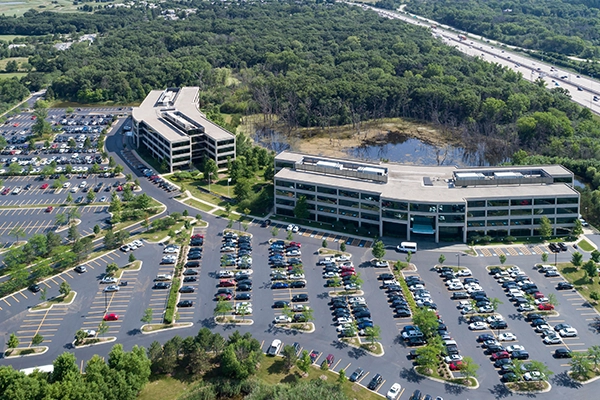How Summer Wears Down Your Commercial Roof.

Commercial roofs take a beating during the summer. With extended UV exposure, extreme heat and daily thermal cycles, even the most durable roof systems like TPO, EPDM and PVC are under constant stress. While these materials are built to perform in tough environments, they can degrade or fail without proper maintenance. Once a summer storm or hurricane hits, that hidden wear and tear may turn into costly water intrusion. Here's a breakdown of the key summer-specific challenges your commercial roof faces and how to stay ahead of them.
✔ UV Exposure
Over time, UV radiation breaks down your roof membrane, leading to blistering, cracking, premature aging and a loss of flexibility. Even reflective membranes can diminish their protective properties if they're dirty, weathered or poorly maintained.
✔ Thermal Expansion and Contraction
In regions where day-to-night temperatures vary widely, roof membranes and other roof components are affected by the daily expanding and contracting of your building. This constant movement stresses seams, adhesives and flashings, increasing the risk of leaks or membrane failure and allowing water intrusion during heavy rain.
✔ Prolonged Heat Exposure
Extended exposure to extreme temperatures can accelerate the breakdown of adhesives and reduce membrane elasticity. Older roofs are especially vulnerable, becoming brittle and more likely to crack or split.
✔ Moisture Build-Up
Hot temperatures combined with humidity push your roof's moisture resistance to the limit. Condensation and trapped moisture beneath the membrane can lead to insulation damage, mold and even structural issues. Poor drainage and ponding water only make the problem worse, especially if not detected early.
✔ Vegetation Growth
Sunlight, humidity and summer heat create ideal conditions for algae, moss and even weeds to grow on your commercial roof. Left unchecked, this vegetation can trap moisture, speed up membrane decay and damage other components of your roof assembly. In some cases, plants or root systems can burrow into cracks, making them worse. Vegetation build-up also creates slip hazards for anyone accessing the roof.
✔ Debris and Storm Damage
High winds from summer storms or hurricanes can bring leaves, branches, dirt and other debris onto your roof. This debris can clog drains, block scuppers and create optimal conditions for various pests. Clogged drainage leads to ponding water, which increases stress on the membrane and raises the risk of leaks.
What to Do
1. Start with a Roof Inspection
Begin with a comprehensive commercial roof inspection to assess the current condition of your roof. Use modern tools like thermal imaging drones for a fast, detailed analysis, especially useful for large facilities or multi-building campuses. A comprehensive inspection from CentiMark will come with photo documentation and repair recommendations so you can plan your next steps with confidence.
2. Book Repairs and Cleaning as Soon as You Can
Complete repairs as soon as possible, especially with storm and hurricane season in full swing. Delaying can turn minor issues into major expenses.
3. Stick to a Maintenance Plan
Enroll in a customized commercial roof maintenance program. Regular inspections and maintenance plans by CentiMark help catch issues like seam failure or punctures early and can significantly extend your roof's life.
Level Up Your Roof: Improvements that Fight Heat and Help Extend the Roof’s Life
If your roof is under constant stress from UV, summer heat and unpredictable weather, it may be time to think beyond basic maintenance. Strategic upgrades like cool roof systems and protective coatings can reduce surface temperatures, improve energy efficiency and extend the life of your commercial roof.
1. Cool Roof Systems
If your current membrane is dark and non-reflective, consider upgrading to a cool roof system. Materials like white or light colored TPO and PVC are naturally reflective and may help reduce rooftop temperatures by 50 degrees or more.
Benefits include:
✔ Lower rooftop temperatures
✔ Less stress from thermal cycles
✔ Lower HVAC loads and energy costs
Roofs with dark-colored membranes absorb more heat, making your building hotter and contributing to pressure on your facility's cooling system. A reflective membrane keeps things cooler inside and out.
2. Commercial Roof Coatings
Particularly for aging membranes, roof coatings offer an easy way to restore performance and postpone a complete tear-off. Coatings work especially well in hot weather and offer several advantages:
Benefits include:
✔ Improving UV resistance and reflectivity
✔ Sealing small cracks, splits and seams
✔ Extending roof life
✔ Improving energy efficiency
Roof coatings are compatible with all major roof systems, including TPO, PVC, EPDM, metal and modified bitumen and are a great option for waterproofing and preserving your asset.
Summer is peak stress season for commercial roofs. From UV rays and thermal expansion to humidity, storms and vegetation growth, the challenges are constant. Whether you manage a single facility or a large portfolio, staying proactive with inspections, repairs and system upgrades can prevent emergencies, lower energy costs and keep your building dry all summer.
When you subscribe to the blog, we will send you an e-mail when there are new updates on the site so you wouldn't miss them.
We use cookies to improve your experience on our website. By clicking "I accept" or continuing to use our site, you consent to the use of cookies unless you have disabled them. Learn more here: Privacy Policy and CCPA.
